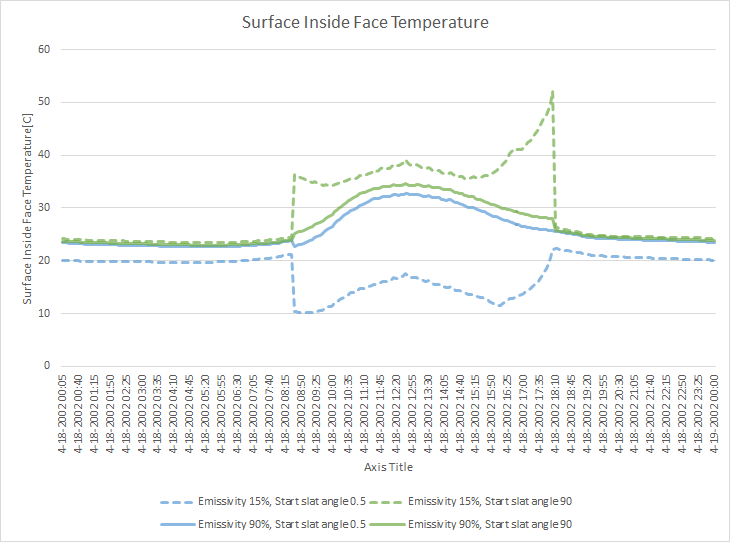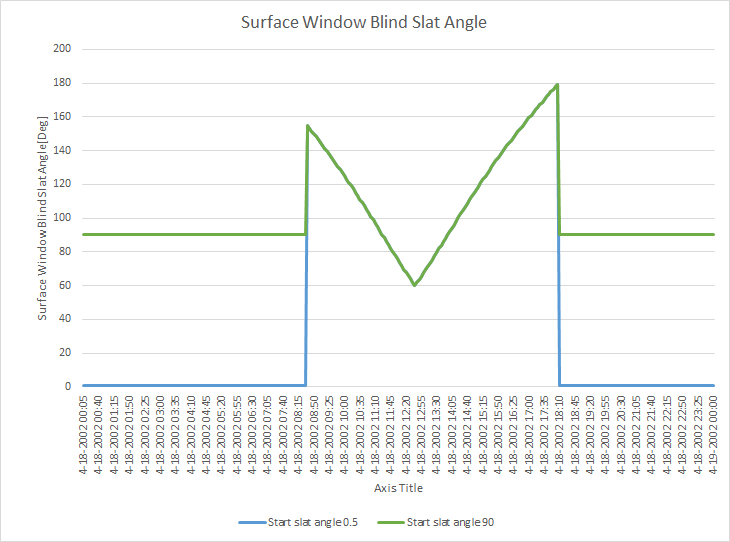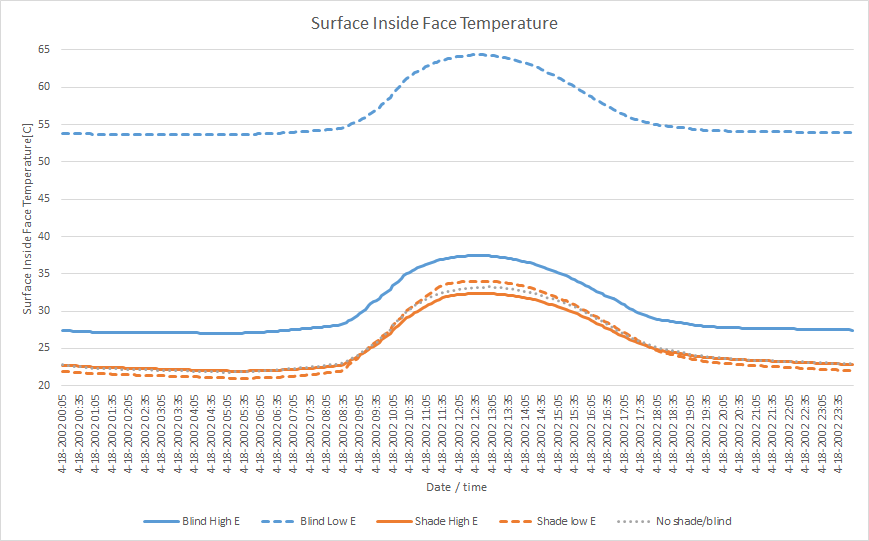Hi,
I am having problems with modelling low-emissivity blinds in Energyplus using the WindowMaterial:Blind object. I am trying to model vertical blinds made of a fabric with a metalized coating on the window facing side which increases solar/visual reflectance and decreases it’s IR-emissivity (see these product specifications as an example). When I use low IR-reflectance values I get results which are peculiar. I have tested the low-E blinds using a multitude of control strategies (fixed, blockBeamSolar, custom EMS scripts). All of them give unexpected results. In short; depending on what I enter under Slat Angle within the WindowMaterial:Blind object I get either extremely low or extremely high surface temperatures for the blinds (and as a result extremely high radiative and convective exchange and resulting cooling/heating). The strangest thing is that the Slat Angle input even has this effect in cases where the input should not even be used by EP, such as when I overwrite the it using EMS (both when actuating window shading control as well as when actuating through a schedule).
The pictures below shows this effect. These simulations follow the blockBeamSolar control strategy. In the middle of the day the initial slat angle should not have any effect whatsoever as blockBeamSolar only uses it when there is no beam solar. Yet its input value is causing the blind to be extremely cold or hot (zone air temp is 20-25).


I also compared the blinds to a windowMaterial:Shade with ‘similar’ properties (for as far as that is possible as the shades properties are not angularly dependent) both fully closed positions. I believe that outputting surface temperature with windowMaterial:Shade might actually output the glass inside temperature and not a the effective temperature like with that in the blinds model. Nonetheless the differences between outputs shouldn’t as large as they are. The increased temperature at the start in these runs is because the blinds have been closed throughout the warmup period. Here too the picture completely changes when I edit the Slat Angle in WindowMaterial:Blind.

I am modelling the low-emissivity blinds as having with a low emissivity on both sides (see reason below). I have also tried modelling them with low-E on the front and regular at the back.
I am using EnergyPlus 8.5. I know that with complex fenestration states in EP 8.5, assymetrical emmissivities can give bugs. Therefore I retried similar studies in 8.9. All give the same results.
I tried varying sets of material properties. Only the ir-emissivity appears to give these strange results.
The models that I use give plausible results when simulating with regular emissivity. Although the slight dip/rise depending on ‘slat anlgle in WindowMaterial:Blind’ seen in the first figure does occur in the time of the day where this input should not have any effect.
I am using argon filled solar controlled double glazing with a coating on the interior of the outer pane. My settings for the blinds object:
WindowMaterial:Blind,
MATBLND_KINDVERT_RF80_T02_A18_E15, !- Name Vertical, !- Slat Orientation 0.127, !- Slat Width {m} 0.0635, !- Slat Separation {m} 0.00025, !- Slat Thickness {m} 0.5, !- Slat Angle {deg} 0.17, !- Slat Conductivity {W/m-K} 0.02, !- Slat Beam Solar Transmittance 0.80, !- Front Side Slat Beam Solar Reflectance 0.80, !- Back Side Slat Beam Solar Reflectance 0.02, !- Slat Diffuse Solar Transmittance 0.80, !- Front Side Slat Diffuse Solar Reflectance 0.80, !- Back Side Slat Diffuse Solar Reflectance 0.02, !- Slat Beam Visible Transmittance 0.80, !- Front Side Slat Beam Visible Reflectance 0.80, !- Back Side Slat Beam Visible Reflectance 0.02, !- Slat Diffuse Visible Transmittance 0.80, !- Front Side Slat Diffuse Visible Reflectance 0.80, !- Back Side Slat Diffuse Visible Reflectance 0.02, !- Slat Infrared Hemispherical Transmittance 0.15, !- Front Side Slat Infrared Hemispherical Emissivity <-- set to 0.9 in the ref. case 0.15, !- Back Side Slat Infrared Hemispherical Emissivity <-- set to 0.9 in the ref. case 0.065, !- Blind to Glass Distance {m} 0.5, !- Blind Top Opening Multiplier 0.5, !- Blind Bottom Opening Multiplier 0.5, !- Blind Left Side Opening Multiplier 0.5, !- Blind Right Side Opening Multiplier 0, !- Minimum Slat Angle {deg} 180; !- Maximum Slat Angle {deg}
Some additional context: The system I am trying to model uses a sun-tracking control strategy which orients the face normal of the blind towards the sun which I implemented in EMS (this strategy is not the same as the blockBeamSolar strategy). EnergyPlus only allows slat angles between 0-180 degrees, meaning that if I want the blind to face the sun directly I need the back side of the blind to face the sun in the morning and the other side of the blind in the afternoon (I am modelling a south facing room). This brings about the problem that both sides become the ‘front side’ at some point in the simulation, meaning it is not possible to have a certain set of material properties consistently face the sun. The implementation of this strategy works as expected as long as I do not use low-Emissivities for the blind.
I am aware that using the complex fenestration state approach might be more suited for this purpose. However I am trying to investigate the influence that different degrees of modelling complexity have on the performance prediction of advanced shading strategies, so I deliberately want to see how far I can get with the simpler approach. At a later stage I am going to implement more complex methods.




